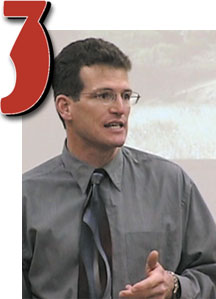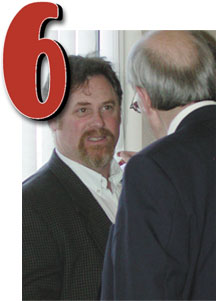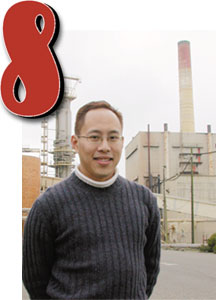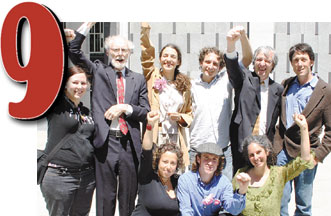|
COVER
STORY | IN THE NEWS | ARTBEAT |
DIRT December 22, 2005
THE FALL OF MAXXAMEarlier this month, Forbes magazine thought it a good time to peer into its crystal ball and divine what the future held for Houston businessman Charles Hurwitz, owner of Maxxam Corp. and its local subsidiary, the Pacific Lumber Co. It saw turmoil ahead -- bankruptcy, a breakup of Hurwitz's company and the loss of his vast Humboldt County timber holdings. "Whatever Maxxam ends up with won't be much," the magazine said. The writing has been on the wall for a while, now. It's now been 20 years since Hurwitz sauntered into Humboldt County, selling off or mortgaging assets of the old Pacific Lumber Co. -- a much-beloved family-owned business and a pillar of the local economy -- in order to fund his takeover of the company. By the end of it, the company was in hock to the tune of nearly $1 billion, all money the company spent for the pleasure of being owned by Maxxam. After the takeover, the company doubled or tripled its cut rate, earning it the permanent scorn of activists and even other timber companies. But it wasn't the activists that this year all but sealed the company's tomb -- at least not directly. The pressure that finally caused the company to buckle came from two sources: Tough regulation from state water quality regulators and, perhaps surprisingly, new intransigence from the holders of the company's timber bonds, the remnants of the debt Hurwitz placed on the company in order to buy it. The company's battles with the North Coast Regional Water Quality Control Board came to a head early this year, when the board's staff refused to allow the company to do all the logging it wished in the Elk River and Freshwater Creek watersheds. The board was (and still is) in the process of developing watershed-wide standards limiting logging in those areas in an effort to minimize the siltation in the streams. The company appealed the decision to the agency's board of directors, which decided to relax its staff's ruling a bit. Later, though, in an appeal brought by the Humboldt Watershed Council and others, a statewide water quality board froze all logging in the two watersheds. Meanwhile, in July, the company barely made its $28 million interest-only payment on the timber bonds, which are backed by the land itself (whose title is held by another Maxxam subsidiary, Scotia Pacific). The Securities and Exchange Commission reports filed by Maxxam and Scopac warned of drastic action -- layoffs, restructuring, bankruptcy. Maxxam officials met with the note holders in an attempt to get them to renegotiate the debt. Hurwitz offered them a 90 percent stake in his timberlands in exchange for a debt reduction, but the note holders balked when he insisted that trees from those lands had to be sold to the Palco mill exclusively. The company's next payment to shareholders comes due next month. If, as expected, the company pulls together enough cash to meet its obligation, it will immediately have to start thinking about the payment after that, due in July. According to their attorney, the note holders are patient. And they're already seeking to shed Maxxam's status as a bête noire of environmentalists and regulators. "Scopac's redwood forests are an important resource, and the noteholders intend to pursue a more responsible timber harvesting and reforestation program that is sustainable over the long term," said a press release.
BAYFRONT PROPERTYWhat a meeting that was, that convocation of the Humboldt Taxpayers' League back in June! The hall was packed! People were all riled up! The staid and stodgy organization probably hadn't seen that much action since the days Howard Jarvis walked the Earth. Of course, the Taxpayers' League's board of directors was pretty silent throughout. In fact, they said barely a word. They were mostly there to get screamed at, and there were plenty of people who wanted to scream. The League's lawsuit against the city of Eureka's Redevelopment Agency and two local developers did bring out the passions in people, whatever else it did. This was understandable. For the first time in ages, Eureka was turning its face back to the waterfront, finally clearing away the detritus left over from the industrial era and building something new and beautiful for the city. The lawsuit threatened to gum up the gears something fierce. The League charged that developers Dolores Vellutini and Glenn Goldan, both of whom sat of the city's Redevelopment Advisory Board, broke state conflict-of-interest law when they entered into contracts with the city to develop two parcels on the Old Town waterfront. In their roles as members of the RAB, Vellutini and Goldan had meticulously recused themselves from voting on their own projects, the League acknowledged, but that was not enough under state law. Eureka City Attorney Dave Tranberg and the developers disagreed. Whatever the case, many Eureka residents hoped they could shout down the League so that work could go forward. In this, they were partially successful. The League dropped the suit, but announced that League member Sue Brandenburg would carry it forward, if necessary. Frustrated, Goldan gave up his contract to develop his parcel, resigned from the RAB, stating that he would resubmit his project, starting the process all over again. The threat of the lawsuit against Vellutini still stands, hobbling further development on the site. When the one project on the water that was close to completion -- the DeBeni/Pierson development at the foot of F Street -- burned to the ground in October, it seemed somehow representative of all the time the city has lost in getting things going down on the bay. But despite the fire, despite the lawsuit, the revitalization of the waterfront is proceeding great guns. Decent lots are going quick. The city appeared poised to award two of them at this Tuesday's meeting, after the Journal went to press -- a spot by the Wharfinger Building for a Hampton Suites hotel and a spot by Halvorsen Park for an "Eco-hostel," a combination youth hostel/appropriate technology center. Of course, the big development -- in every sense of the word -- is going to be taking place right across the street from the potential home of the Hampton Suites, at the long-defunct Balloon Track. Rob and Cherie Arkley, who are said to be on the verge of finishing up their long-running bid for the site, are meanwhile getting ready for the biggest development fight the city has seen since 1999, when voters denied Wal-Mart the right to build on the very same site. According to reports, the Arkleys are pushing for a double big-box development, with a Home Depot and maybe a Best Buy anchoring what would essentially be a new mall. This project, unlike the others, is going to face a stiff political fight.
LAND USEIt seemed like rarely a week went by without someone sticking it to the Humboldt County Planning Department. Ranchers, developers, political leaders -- everyone stepped up to deliver a kick. If it wasn't Rob Arkley vowing to see the entire department fired, it was Supervisor Jill Geist wondering why the department's customer service seemed so lousy, or ranchers like Joe Russ wondering why staff members couldn't understand the meaning of a simple word, such as "contract." For the developers, much of the fight was left over from the previous year, when Humboldt County approved a new "housing element" to its general plan. The housing element is required by state law, and it is meant to account for all the land needed to build homes for new Humboldt County residents. According to the state agency charged with reviewing the plan, it did so. But a group calling itself Humboldt Economic and Land Use Plan -- a group that, by 2005, seemed to consist solely of Arkley and a Sacramento consultant -- fought to see it overturned, charging that the department had included a substantial percentage of unbuildable lots in its inventory. Meanwhile, ranchers protested at the county's unilateral alteration to Williamson Act contracts -- contracts meant to preserve the county's agricultural land by offering tax breaks to people who agree not to subdivide their land. The county maintained that it could alter the terms of such contracts when it wished, in order to keep contracts in conformity with state law and local regulations. Ranchers said that was nonsense, and that a contract was a contract. They seemed to win a victory when a judge ruled likewise in the Tooby Ranch case, a case stemming from the non-permitted subdivision of a southern Humboldt Williamson Act ranch a few years ago. (That ruling is currently being re-reviewed, and may not stand.) The county is still in the process of devising its new general plan, a document that will serve as the constitution for future development in the county. In the past, the planning department staff have shown themselves to be squarely on the side of those who believe that one of the principal threats facing the county is sprawl. Could the scars they contracted during this year's wars have softened their position?
4. THE YEAR IN GALLEGOSIt would be hard to picture anyone arguing that it was a good one -- except, perhaps, those who would dearly love to see the back of him. The road didn't really get rocky for District Attorney Paul Gallegos until the summer. Then, in late June and early July, everything seemed to hit at once. Deputy DA Worth Dikeman announced that he would challenge Gallegos in next year's election, kicking off the campaign a year before election day. A Humboldt County Grand Jury report took him to task for the way he ran the office. A bizarre, baroque turn of events in the conflict-of-interest suit against Fortuna City Councilmember Debi August -- a politically radioactive case that the office was prosecuting -- ended with a judge dismissing the case right before it was supposed to go to trial. But none of these things had quite as severe an impact on Gallegos' reputation as the dismissal of his office's sweeping fraud lawsuit against the Pacific Lumber Co. The case was filed by Gallegos' right-hand man, Tim Stoen, just weeks after Gallegos took office in 2002. In the years that followed, through the bitter recall fight that the suit sparked, his supporters and detractors could tacitly agree on one thing: Gallegos was the fraud suit, and the fraud suit was Gallegos. It never would have been filed if he hadn't been elected, and he and Stoen fought it whole hog -- even going so far as to bring a local judge's sex life into court filings in order to get that judge disqualified. It backfired. The judge they got instead was the one that dismissed it. (His ruling has been appealed.) The death of the August and Palco cases marked the end for Stoen, who Gallegos -- a former defense attorney -- originally hired to bridge the gap between the office and himself. As Gallegos later noted, that plan didn't work so well. Stoen retreated to his old job as a Mendocino County prosecutor. To fill Stoen's shoes, Gallegos hired San Francisco defense attorney Jeffrey Schwartz, whose pre-hire website -- www.yougofree.com -- occasioned a few courthouse snickers when it was discovered. Then, in September, the DA's friend and political consultant Richard Salzman became mired in scandal (see below). Unlike other candidates Salzman had worked with, Gallegos was slow to distance himself, saying that he needed to speak to Salzman directly before he made judgments. Apparently, that chat never took place. On Monday of this week, Gallegos finally seemed to say that his political future will be Salzman-free. Gallegos himself says he's staying focused on the job at hand, but for his still-devoted supporters, everything points to June 6, 2006. It'll be Gallegos' third election in four years. This time, unlike the last two, Gallegos will be running on his record -- not against Terry Farmer, a 20-year-incumbent, and not against the hundreds of thousands of dollars Pacific Lumber spent to try to remove him. Dikeman is a strong law-and-order candidate with strong law-and-order support. With the Pacific Lumber case -- and Pacific Lumber itself -- on the sidelines, there's simply no telling which way things could go.
NEWSPAPER WAR"Without fear or favor," says the Times-Standard. "A new standard," says the Eureka Reporter (yes, pun intended). Both papers are running new ad campaigns, the Times-Standard's notably lower-budget than the Reporter's. In the 21st century, at a time when newsprint is going the way of the reel-to-reel recorder, only cities on the scale of New York can afford a full-scale newspaper war, or even more than one newspaper. Except Eureka. The Reporter, which was nothing more that a twinkle in Rob Arkley's eye three years ago, is now poised to make a serious run at the 151-year-old Times-Standard, thanks to the millions lavished upon it by Arkley, who wears many hats -- a hugely successful businessman, a developer taking a big position in downtown Eureka and a generous donor to: (a) beautification projects in the city of Eureka, and (b) Republican candidates and causes. A few weeks ago, the paper threw a party to show off its new downtown offices and its new printing press (on which the Journal is also printed). Both were a newspaper person's dream -- light, airy spaces; brand new computers; laptops; cell phones. It's no exaggeration to say that the paper itself is beautiful, thanks to the talents of its designer, Kevin Bell. Unlike the rest of the Humboldt County press corps, the eager young reporters at the Reporter have all the tools to do the job properly. Again unlike most of the press corps, they are paid something approximating a living wage. You may wonder: Is this an investment or a bribe? What kind of beast is the Reporter, in the end? It runs all sorts of voices tucked back in the opinion pages, and that may be what Managing Editor Glenn Franco Simmons is thinking of when, with tongue nowhere near cheek, he calls the paper "fair and balanced." With a little over two years of reporting behind it, though, it's hard to think of a single Reporter news story that may have caused Arkley or his friends -- the people that run the town, in large part -- even a moment of discomfort. It's not so hard to remember the occasions that the paper has valiantly rallied to the boss' side after the appearance of a less-than-flattering story in the Times-Standard. Stay tuned. The Reporter goes daily on Jan. 1. Shortly afterward, Cherie Arkley will pitch her proposed big box development (see above) to her former colleagues on the Eureka City Council. In the months of fierce debate that will certainly follow, the reading public will find out what role fear and favor play at the Eureka Reporter.
THE 99 NAMES OF SALZMANAs a wise man once said: Before you point your finger, make sure your hands are clean. Richard Salzman -- founder of the Alliance for Ethical Business, lead politcal strategist for DA Paul Gallegos -- was, in the early half of 2005, well on his way to establishing himself as a king-maker for the local progressive community. His main weapon was his index finger, which he deployed with great talent against his enemies, pointing out dastardly deeds. (The middle finger was only implied.) In September, all that came to a halt. That's when this newspaper discovered, then proved, that for at least a year Salzman had written a series of letters for publication in various local newspapers under a series of quasi-fake names -- names just close enough to those of actual Humboldt County citizens to seem plausible. Looking back at them, the letters themselves were clearly designed to continue Salzman's work through other avenues, ones that would remain sub rosa. They were exemplars of the black arts of politics, the kinds of thing that Karl Rove might have done in his boyhood. The Eureka Reporter officially reported Salzman's actions to the Trinidad Police Department, which then proceeded to investigate the matter as a case of identity theft. (Simmons said that he did not consult Arkley -- an avowed Salzman enemy -- before calling the police.) A search warrant was served on Salzman's home, and his computers were confiscated and sent away for analysis. Salzman went quiet for a few months. Political progressives got a glimpse of the long-term fallout in the run-up to the November elections. McKinleyville Community Services District candidate Bill Wennerholm attacked two of his opponents -- Jeff Dunk and Javan Reid -- for being endorsed by Local Solutions, the leftish political action committee that was formed after the recall. The nut of his argument? Local Solutions is nothing more than a cog in Salzman's dirty-tricks machine. The PAC was pulling Dunk and Reid's strings, and Salzman was pulling the PAC's. (In the end, Wennerholm, Dunk and Reid were all elected.) "I'm pleased that the matter has been resolved, and I look forward to returning my attention to the vital quality-of-life issues facing Humboldt County," Salzman said in a press release last week after the state attorney general's office declined to take the case to court. But whether that attention will be effective, or even welcome, remains to be seen. Certainly, Salzman's old and often accurate harangues against dirty politicking on the right will no longer pack quite the same punch. And with several key political races coming up next year -- Gallegos' reelection campaign, two county supervisors' seats, Eureka's mayor and the majority of its city council -- the Wennerholm critique will surely be refined and redeployed against other progressive candidates.
ALL ABOARDThe problem: Poverty, mill closures, rising home prices, the end of the American Dream. The solution: To pull back the Redwood Curtain just a bit, to invite outsiders to invest in new businesses that will give Humboldt County workers a decent wage. The silver bullet: To revive Humboldt Bay as a working port, to rebuild the comatose Northwestern Pacific Railroad line, to bring in goods and to move 'em out -- ships, trains, trucks, cranes, longshoremen, bustle, sweat. Some believe it's the silver bullet -- or something close to it, anyway. Among them are almost all of our elected officials, from the most junior city councilman all the way up to Congressmen Mike Thompson. And they worked hard this year. The Humboldt Bay Harbor, Recreation and Conservation District -- one of the key bodies promoting harbor/rail development -- sent a delegation to China to schmooze industrialists, in the hope that they might put some funds into developing port and rail facilities, or to pressure the state and federal government to do so. The North Coast Railroad Authority, a state agency with custody of the railroad line, persuaded Congress and the California legislature to ease up on the agency's debt. For every step they took, though, the ground beneath their feet moved at least as far in the opposite direction. Evergreen Pulp started moving most of its product by truck. Westfall Stevedore, the last locally owned cargo handler on the bay, went out of business. Gov. Schwarzenegger vetoed the railroad's debt relief legislation. The Port of Oakland, which is still touted as a very interested partner in development of Humboldt Bay, announced a new cooperative agreement with the Port of Sacramento. When this paper contacted him in June, Oakland's director of maritime operations said, in essence, best of luck to you, but there's not a lot we can do. Then, in November, the citizens of the Arcata area elected a skeptic -- Mike Wilson -- to serve on the harbor district's board of directors. Wilson ran an insurgent campaign, and his critique was simple: While we're all standing around like some Melanesian Cargo Cult, making offerings to the gods of government and commerce in the hope they'll send some ships our way, there's a whole lot we're not doing. For instance, we have no bike trail around the bay, and we have very few put-in spots for boaters and kayakers. Let's fix that, and won't that also make Humboldt County an incrementally more attractive spot for business and commerce? It's still a minority opinion. Count on Wilson being at the short end of many 4-1 votes for the next couple of years, at least.
PULPIn January, the timber industry was in a very bad way. The Samoa pulp mill had closed its doors; its owners, Stockton Pacific, had thrown in the towel. With the mill out of business, wood waste was stacking up in mill yards all over Humboldt County. Some mill owners hauled their chips up to market in Oregon, others just put them into a big pile and hoped for the best. Then, just a week or so later, in stepped Lee & Man, a Hong Kong-based pulp and paper concern. They paid off the mill's debts, got it up and running and made a full-court press to introduce themselves to the community. Everyone agreed, at first, that this new company was a breath of fresh air. Personable, committed, engaged, funded -- Lee & Man had everything going for them. They renamed the company Evergreen Pulp. That breath of fresh air lasted a few months, then it turned a bit foul. The mill accidentally released a cloud of sulfurous gas in May, reminding everyone in Eureka of the town's smelly bad old days. But the more serious problem was that two ancillary pieces of mill equipment were emitting unhealthy, illegal amounts of particulate matter. Some downwind residents organized and raised a fuss. In May, the North Coast Unified Air Quality Management District held hearings on the issue. Evergreen management said that they had been unaware of the problems at the time of the purchase of the mill. Staff members stated their belief that the company was acting in good faith. The district's hearing board granted Evergreen a temporary variance, giving the company six months to get their house in order. Though the company has made progress, things aren't quite so cozy these days. Evergreen and the air quality district haven't been able to come to terms on a long-range solution to particulate emissions at the mill. The district has been talking tougher of late, but is still hoping that it can work with the company. Residents continue to call foul. Hearings will continue next month.
THE PEPPER SPRAY 8Not much needs to be said about it. On three occasions in 1997, officers from the Humboldt County Sheriff's Office and the Eureka Police Department grabbed the heads of nonviolent, stationary logging protestors and, taking Q-Tip in hand, swabbed a noxious chemical directly into their eyes. Videotape footage was taken of each incident, and a few weeks later the national nightly news ran the footage. To the incredulous world, Humboldt County government appeared to be taking directions from some foul Latin American dictator. The officers in question behaved politely to the locked-down protestors, asking them if they understood what was coming. The officers didn't realize that this just made them look worse. They had their reasons, ones the city and county's attorneys recounted in court -- the other method of removing activists from lockboxes, a mechanical grinder, was in fact more dangerous. This even though no one had been injured by a grinder before. And were the grinders specifically designed to put people in pain? After two mistrials, a San Francisco federal jury finally sided with the activists in their civil rights lawsuit against Humboldt County and the city of Eureka. They were awarded only a symbolic $1 each in damages, but money wasn't what they were after. Last week attorneys for both sides agreed that the city and county would pay $750,000 to cover the protestors' legal team. Together, the city and county have paid much more than that to the outside attorneys they hired to fight the case. Except for the ruling itself, the whole affair was a catastrophe from beginning to end.
GIMME STUDENTSHumboldt State administrators got the news they had been dreading in August, just before the fall semester began. In the months to come, the university would have the equivalent of only 6,864 full-time students, 166 fewer than the previous year -- in which the university also fell short of its enrollment goals. Meanwhile, HSU's overlords at the offices of the California State University system's headquarters in Long Beach were tapping their toes. California is a growing state. Why have Humboldt's numbers essentially remained static for the last 30 years? The CSU is taking the question seriously, and so is HSU President Rollin Richmond. The HSU administration has, for a few years, retained a national consulting firm to figure out why so few young people seem to want to come to Humboldt. This year, Richmond's started putting the consultant's recommendations -- and they are many -- into practice. In the beginning of the year, the administration's attention seemed to be focused on whipping the faculty into shape. Following the lead of an inter-faculty committee, Richmond announced decisions about promotion would depend, in part, on each professor's activities in their discipline -- their academic scholarship or, in the case of the arts, exhibitions and critical acclaim. Reaction was mixed. Some professors saw the proposal as tantamount to the "publish or perish" model that reigns at larger research institutions. Others agreed with Richmond, who believed that it would increase the university's prestige and therefore make it more attractive to potential students. Then, during the summer, the university erected the monumental gateway that now frames LK Wood Boulevard. The consultant's report believed that HSU needed to establish or "brand" itself better; Richmond and his colleagues felt that a new piece of architecture near the university's entrance would help fill that bill. Again, the new entry was far from universally popular. Some complained about its design, which echoes the colonial "Mission" period in California history. Others said the money would have been better spent on basic janitorial and groundskeeping services. But with student numbers still dropping, Richmond believes that big, dramatic gestures are required. They may take several years to have the desired effect. In the meanwhile, everyone -- Richmond, the CSU Chancellor's Office and, given the huge economic impact of the school, the county at large -- will be waiting to see if California's high school class of '06 will at least turn HSU's frown upside-down. COVER
STORY | IN THE NEWS | ARTBEAT |
DIRT Comments? Write a letter! © Copyright 2005, North Coast Journal, Inc. |











